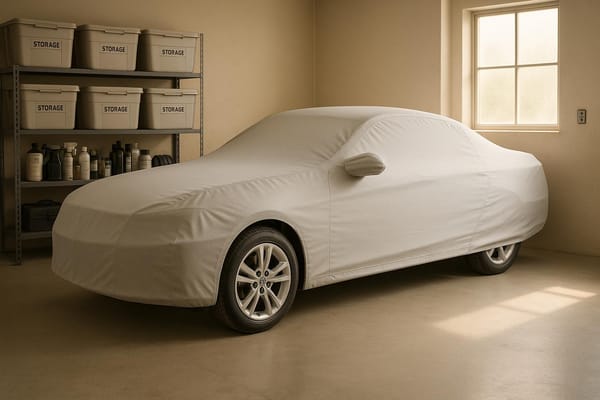How to Choose a Storage Facility for Rare Cars
Learn how to protect your rare car investment with the right storage facility, focusing on climate control, security, and maintenance.

Storing rare cars isn’t just about finding a space - it’s about protecting your investment. Here’s what you need to know to keep your vehicle in top condition:
- Climate Control: Look for facilities maintaining 10–15 °C and 45–55% humidity to prevent corrosion and mould.
- Security: Ensure 24/7 CCTV, alarms, and strict access controls are in place.
- Maintenance Services: Opt for facilities offering battery upkeep, fluid checks, and regular inspections.
- Storage Type: Choose between open bays or private climate-controlled garages.
- Extra Services: Consider detailing, tyre/brake care, and transport options for added convenience.
- Cost and Insurance: Compare prices, check reviews, and confirm insurance coverage for fire, theft, and damage.
INSIDE LOOK into a Car Storage Facility - Collectors Car ...
Basic Storage Needs for Rare Cars
When storing investment-grade vehicles, it's crucial to focus on three main factors: climate, security, and storage duration. These elements work together to ensure your rare car remains in pristine condition.
Temperature and Humidity Control
Maintaining the right climate is non-negotiable for preserving high-value vehicles. The ideal storage environment should have a temperature range of 10–15 °C (50–59 °F) and a relative humidity level of 45–55%. Given the UK's fluctuating weather, professional climate control systems are often necessary. Without proper management, issues like mould and metal corrosion can arise, significantly reducing the car's value.
Security Requirements
Rare and high-value cars need top-tier security. Storage facilities should offer 24/7 monitored CCTV, robust perimeter alarms, and strict access control measures. Additionally, having advanced fire suppression systems in place adds another layer of protection, safeguarding these valuable assets against unexpected incidents.
Short vs Long‑Term Storage
The approach to storage varies based on duration:
- Short-term storage: Regularly starting the vehicle and moving it periodically helps maintain mechanical components.
- Long-term storage: This requires more preparation, including full winterisation and thorough inspections every 90 days to prevent deterioration over time.
How to Select a Storage Facility
Once you know what your car needs for storage, focus on three key factors: location and access, security measures, and climate control. Check how close the facility is and how easy it is to get to. Look into their security setup, including CCTV, alarms, and access logs. Finally, review their records for temperature and humidity control to ensure they can maintain the right conditions for your vehicle.
Extra Services to Consider
In addition to climate control and security, there are other services that can help maintain your vehicle's value and make ownership more convenient.
Regular Car Care
Services like professional battery upkeep, routine engine runs, and thorough fluid checks help prevent wear and tear. Monthly inspection reports provide a clear snapshot of your car's condition and flag potential problems early.
Storage Options
You can opt for open bay storage or private garages with controlled access. For added peace of mind, premium options include climate-controlled pods equipped with individual monitoring systems.
Valet and Transport
Door-to-door collection and delivery services using covered transporters ensure your vehicle stays protected. Scheduled exercise runs help keep the engine in shape and mileage is carefully recorded.
Detailing and Preservation
Detailing services include applying paint protection films and conditioning interior leather. Climate-controlled bays provide an optimal setting for this preservation work.
Tyre and Brake Maintenance
Monitoring tyre pressure and rotating tyres regularly can prevent flat spots during storage. Brake inspections and caliper servicing ensure components remain in good working order.
With these additional services in mind, the next section will explore pricing and quality comparisons.
Cost and Quality Checks
When choosing a storage facility, it's important to weigh up the cost and service quality. This helps protect your car's value while ensuring you're getting what you pay for.
Checking Facility Reviews
Look for verified customer reviews on specialist storage forums or the facility's website. Pay attention to feedback about reliability, cleanliness, and responsiveness. Be cautious of reviews that are undated or anonymous, as they may not be trustworthy.
Insurance Details
Check if the facility's insurance policy covers risks like fire, flood, theft, and accidental damage, based on the agreed market value of your car. Request a copy of their insurance certificate and carefully review any excesses or exclusions.
Price Structure
Ask for a detailed breakdown of costs, including entry fees, monthly rates (per bay or square metre), admin charges, and any additional service fees. Compare the total monthly cost across options and watch out for hidden charges like retrieval fees or penalties for late payments.
Final Checklist
Before making your final decision, go through this checklist to ensure you've considered all the key factors.
With your shortlist in hand, double-check the following:
Security and Access
- Make sure there's 24/7 CCTV monitoring and access-log tracking.
- Review entry protocols and access controls.
- Look into staff vetting processes and emergency response plans.
Climate Management
- Confirm that temperature and humidity controls are in place.
- Check for power backup systems to maintain climate settings.
- Ensure proper air circulation and moisture-control systems are available.
Maintenance and Car Care
- Verify that routine inspections and cleaning services are offered.
- Check if battery maintenance and fluid level checks are included.
- Look into any additional maintenance services they provide.
Reputation and Insurance
- Read recent customer reviews and industry references.
- Ensure insurance covers risks like fire, flood, theft, and accidental damage.
- Verify any necessary licences or certifications are in place.
Pricing and Contracts
- Review the fee structure, payment terms, and billing cycle.
- Check the cancellation policy and required notice period.
- Confirm whether there are extra fees or seasonal price changes.




